Exhibitions
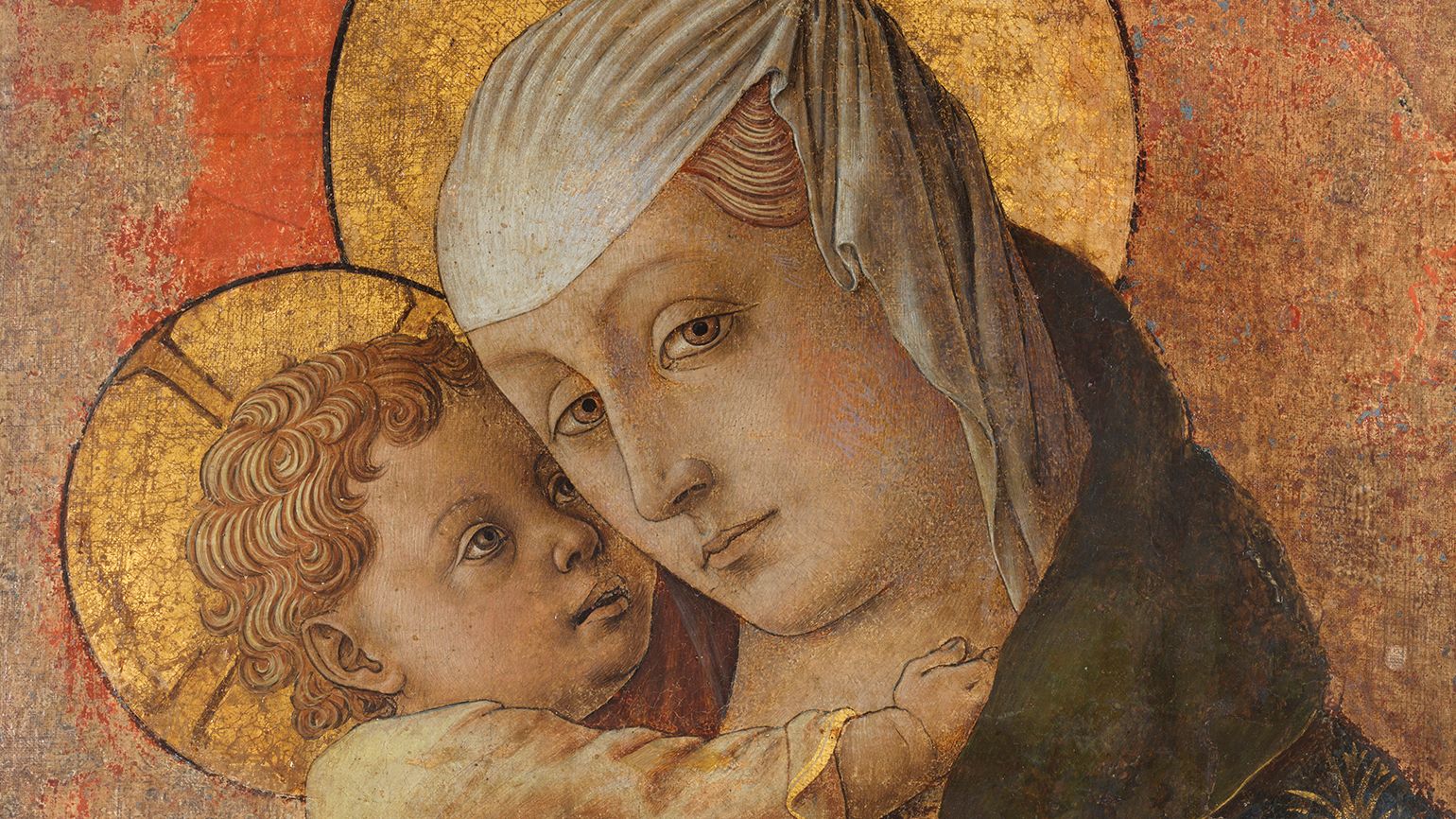
Carlo Crivelli. Wonderful relationships
He does not stay calm, nor does he show that he is satisfied with a taken for granted and repeated creativity; he instead struggles to seek not new compositions, but new formal solutions, almost subjugated by the need for an impossible perfection.
P. Zampetti, 1986
A project dedicated to Carlo Crivelli (Venice, about 1430 – 1435 – Ascoli Piceno ?, 1495) invites the public on a journey of discovery towards the wonders of the painting of one of the Renaissance masters through a land rich in history and art. A path that starts from Macerata, home of the exhibition, inside Palazzo Buonaccorsi and continues in 8 municipalities of the Marche Region that preserve works by the artist or strongly connected to him in a series of, as the title suggests, wonderful relationships.
The occasion of Carlo Crivelli. The wonderful relationships, curated by Francesca Coltrinari and Giuliana Pascucci, is the important restoration work carried out in favor of the Madonna and Child by Crivelli, kept in Palazzo Bonaccorsi and presented for the first time in its full legibility and splendor. The first monographic exhibition dedicated to Carlo Crivelli in the Marche, his adopted homeland, which completes the series of exhibition projects dedicated to him internationally since the 2000s such as Crivelli and Brera, Milan, 2009; Ornament and Illusion. Carlo Crivelli of Venice, Boston, 2016; Crivelli’s golds, Vatican Museums, 2019; Carlo Crivelli. Shadows on the Sky, Birmingham, 2022.
A restless painter, experimenter, full of grace and genius, Carlo Crivelli is one of the most intriguing figures of the fifteenth century. Venetian by birth, following a legal matter in which he was involved, he leaves the lagoon, first arriving in Zadar and then moving to the Marche, definitively influencing the history of art of that territory and beyond. Unknown for decades, rediscovered and adored above all by English Pre-Raphaelite artists, disputed by collectors around the world, Carlo Crivelli today is an independent figure who projects the charm of him, made up of always different inventions, extreme technical perfection and mystery.
Macerata Exhibition
The exhibition inside the extraordinary Palazzo Buonaccorsi, designed in 1697 by Giovan Battista Contini, a pupil of Gian Lorenzo Bernini, collects six paintings, from Italian museums and beyond, selected with the aim of bringing some of the paintings back to the territory of origin of Crivelli and to present the most up-to-date contributions of scientific research and investigation, evincing the many “wonderful” relationships existing between the works, the contemporary masters, the museums that have welcomed them up to today’s visitors.
Next to the Madonna and Child of Macerata will be exhibited: Madonna with Child from the Carrara Academy of Bergamo, Pietà (Dead Christ mourned by the Virgin, St. John the Evangelist and St. Mary Magdalene) from the Vatican Museums, St. Francis collecting the blood of Christ from Museo Poldi Pezzoli in Milan, Christ blessing from the National Museum of Castel Sant’Angelo in Rome as well as a work by his brother Vittore Crivelli, San Sebastiano and devotees kept in the deposits of the Superintendency at the National Gallery of the Marche in Urbino and which will be returned at the end of the exhibition in the city of Montegiorgio, from which it comes.
Click on the images to see them in full screen
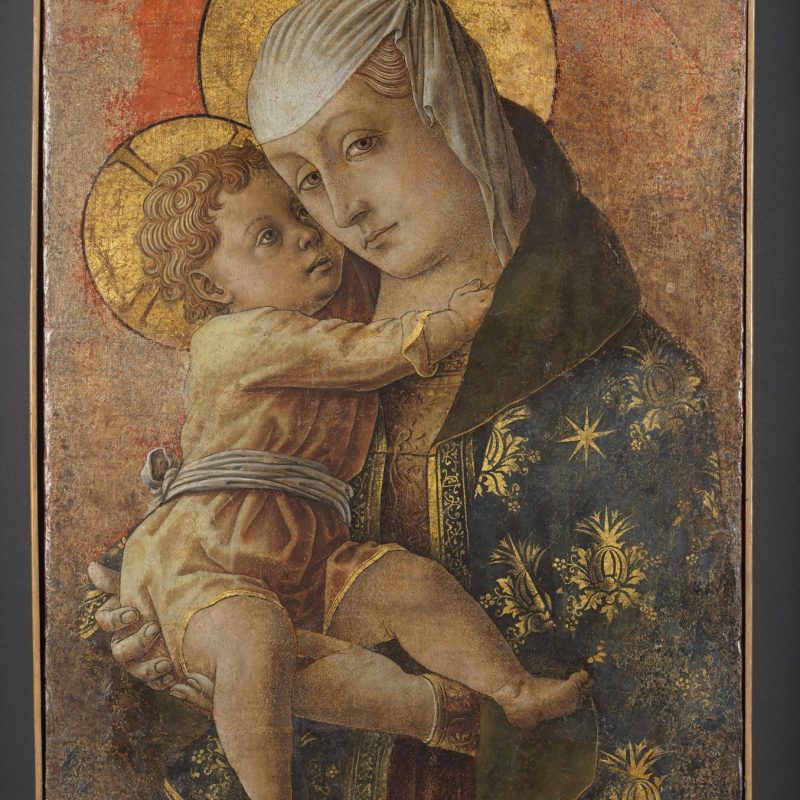
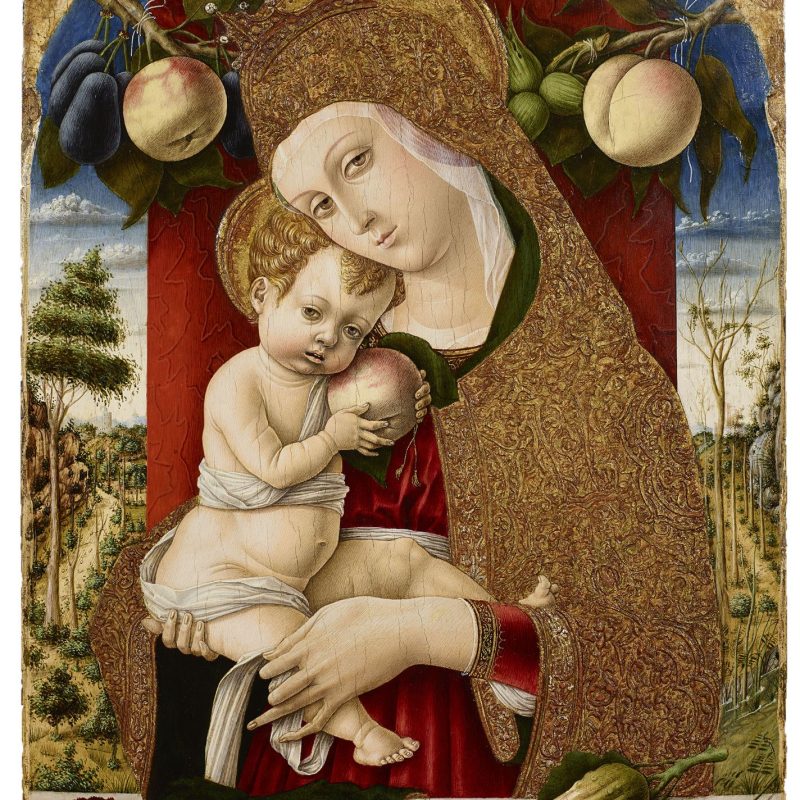
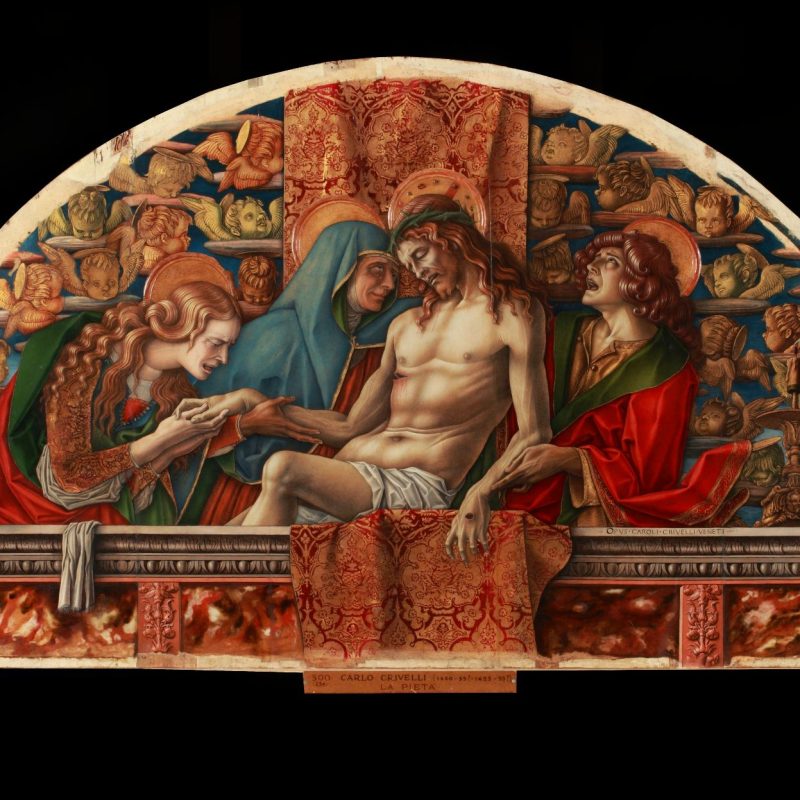
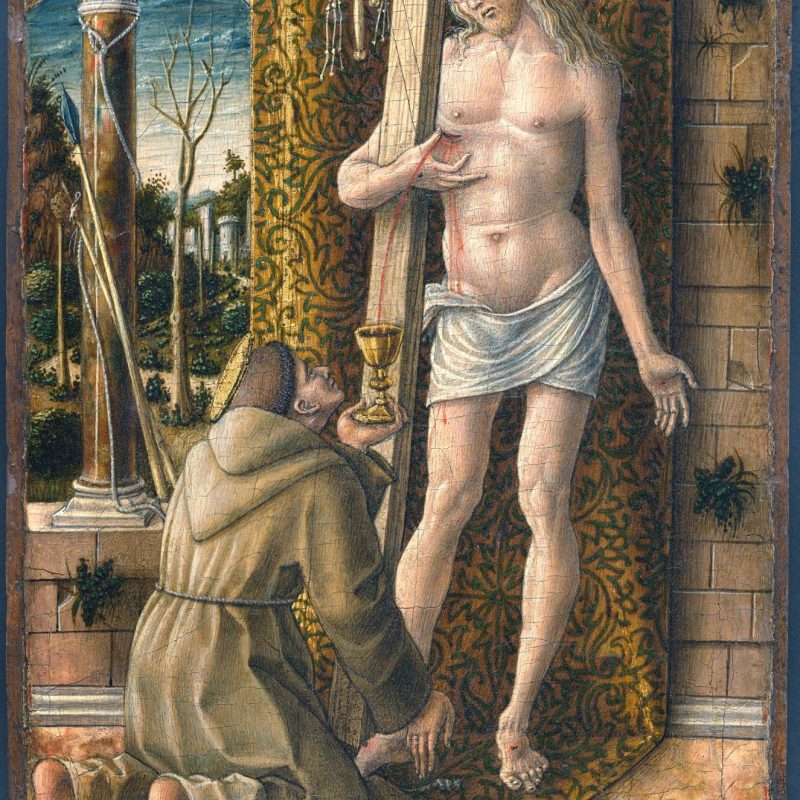
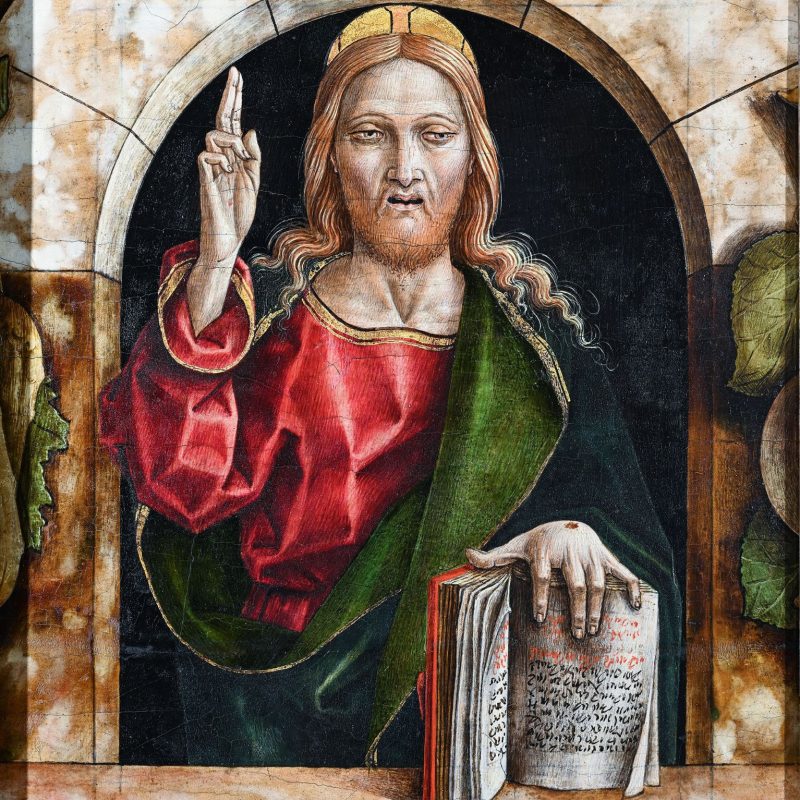
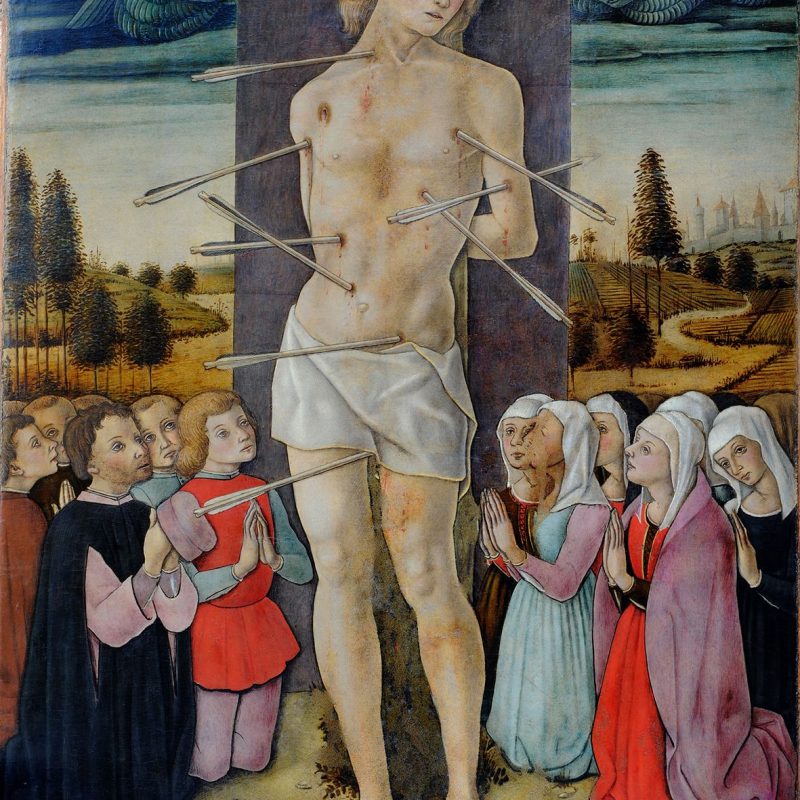
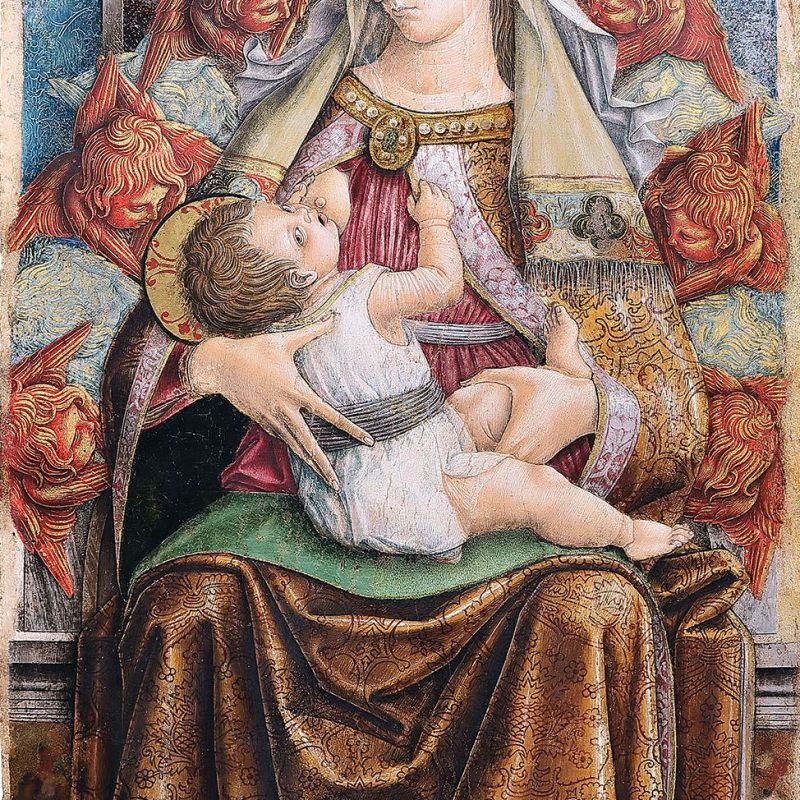
The Wonderful Itineraries
It starts from Macerata, inside and outside Palazzo Buonaccorsi, to then continue towards Corridonia, San Ginesio, Sarnano, Monte San Martino, San Severino Marche, Serrapetrona, Belforte del Chienti. A project that aims to rediscover the work of Crivelli, between large altarpieces and works of reduced size for private devotion, and the link with the Marche region that hosted it (from 1468 to 1495) and in which he created most of his masterpieces.
Crivelli itinerary, a project developed thanks to the collaboration with the University of Macerata, the municipalities concerned and the dioceses of Macerata and Camerino, includes works by the Venetian master and artists strongly connected to him, such as his brother Vittore Crivelli, the pupil Pietro Alemanno, the Vivarini, Giovanni Boccati, Lorenzo d’Alessandro da Sanseverino, examples of the tradition of the Venetian polyptych both imported and made by local masters, as well as Antonio Solario, designated heir of the workshop of the last of the Crivellis.
The exhibition is promoted by the Marche Region and the Municipality of Macerata, in collaboration with the University of Macerata and the Carima Foundation.
If painting had an increase in Venice from one of our Marchians (alluding to Gentile da Fabriano) it was not the least among us for a Venetian, who conducted himself in these places and scattered a great deal of light.
A. Ricci, 1834
Go to The Wonderful Itineraries
Critical fortune
Ignored by Giorgio Vasari, Carlo Crivelli’s critical fortune had to wait decades before being recognized. From the end of the eighteenth century, many of his works entered the antiques market and the unfortunate decomposition of some of his Marche polyptychs began, as well as the addition of signatures which were later declared false. In the nineteenth century, the insistence of research on the relations between Venice and the Marches brings attention back to the master, in any case if on the one hand the history of art deals with him, on the other the market misunderstands him by dispersing, without respect some, many masterpieces. In addition to the Napoleonic suppressions that transferred many works to Milan at the Pinacoteca di Brera, the great migration took place towards Great Britain, so much so that to date, the National Gallery in London preserves the most important corpus of his paintings in the world. Luck in the Anglo-Saxon world is well explained bearing in mind the growing Pre-Raphaelite taste that finds extraordinary references in Crivelli, characteristics that still fascinate today. Many and important art historians who, over the years, have studied and written about Crivelli, from Cavalcaselle to Rushforth, from Venturi to Berenson who tells of the author by writing “and never tires us”, as well as Longhi, Zampetti, Davies and Zeri, up to the most recent research by Lightbown, Daffra, Di Lorenzo, Campbell Golsenne, Hilliam and others which confirm Crivelli one of the most singular, restless, experimental, precious, extraordinary talents of the fifteenth century.
Short biography
Carlo Crivelli, son of art and brother of the painter Vittore (with whom he had bad relations but from whom he was always followed and imitated), was presumably born between 1430 and 1435 in Venice. He soon leaves the lagoon following a conviction for concubinage with a sailor’s wife. Compared to the early Venetian years, there are no works documented with certainty and it has been hypothesized that Crivelli was formed with the Vivarini or with the Bellini. On the basis of his figurative culture and style, however, the frequentation of Padua in the mid-15th century is certain, characterized by the presence of Donatello and Filippo Lippi and by the Squarcione workshop. After the conviction in 1457, the artist travels to Zadar, a Croatian city at the time part of the Serenissima; later, following the routes of merchants and artists, he arrived in Fermo, in the Marche region and after a few years fixed his residence in Ascoli Piceno. His presence is attested in various centers of the Marches such as, for example, in addition to Macerata and Ascoli, in Camerino, Matelica, Fabriano and Pergola. In 1489 he obtained the title of knight, almost certainly for his artistic merits. There is news of his death in 1495, it is not certain whether in Ascoli or Camerino, from a letter from his brother Vittore claiming his inheritance.
Date e orari
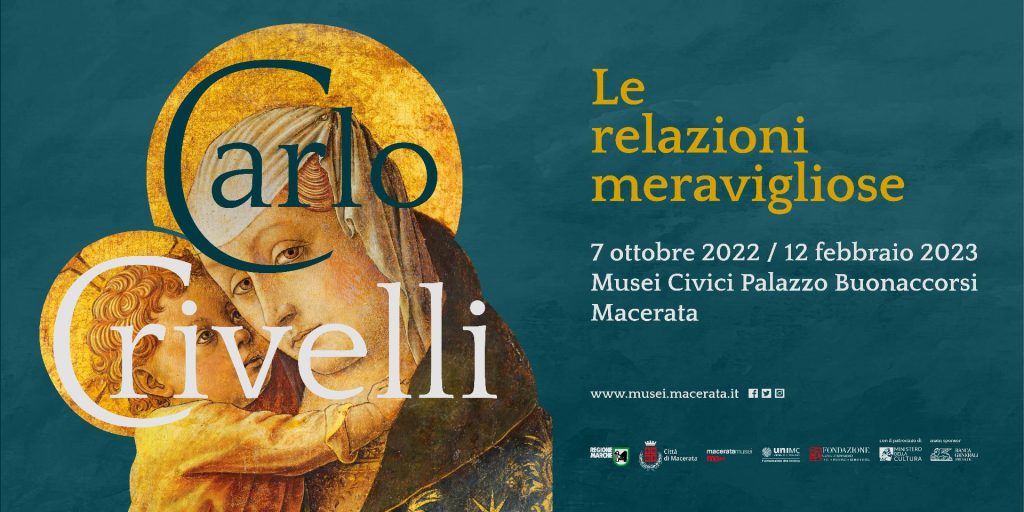
CARLO CRIVELLI. LE RELAZIONI MERAVIGLIOSE
Macerata, Palazzo Buonaccorsi e Regione Marche
October 7th 2022 – February 12th 2023
curated by Francesca Coltrinari and Giuliana Pascucci
tuesday – sunday 10-13 | 14.30 – 18.30
Extraordinary opening days: October 31st, December 26th, January 2nd, January 9th
Closing days: December 25th, January 1st
Extraordinary Openings
The Civic Museums of Palazzo Buonaccorsi (collections and exhibition “Carlo Crivelli. The wonderful relationships”) from Saturday 29 October to Tuesday 1 November will be open all day, from 10.00 to 18.30 (last admission 30 minutes before)
Monday 31 October the exhibition “Carlo Crivelli. The wonderful relationships” will also be open in the evening, from 20.30 to 23.00
Tickets
Standard admission tickets € 9,50
Concessions € 7,00
University and Fine Arts Academy students, parties of 15 or more, members of FAI, Touring Club, COOP Alleanza 3.0, Italia Nostra residing in the municipality of Macerata.
Concessions (School) € 4,00
Reserved for schoolchildren from junior and upper secondary schools of the municipality of Macerata.
Free entry
ICOM members, children up to 13 years of age, journalists with a regular journalist identification card, Marche Region tourist guides with a regular membership card, and disabled people with an accompanying person.
To buy the tickets click here.